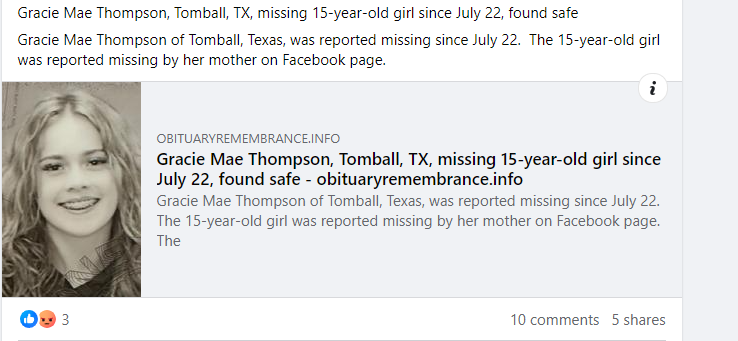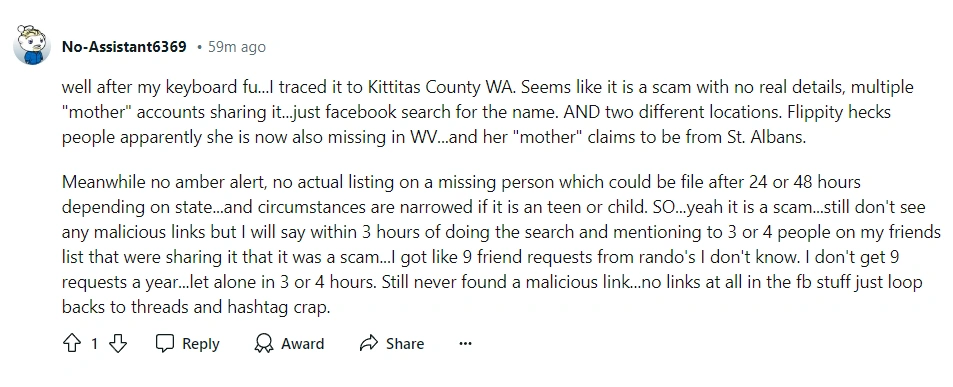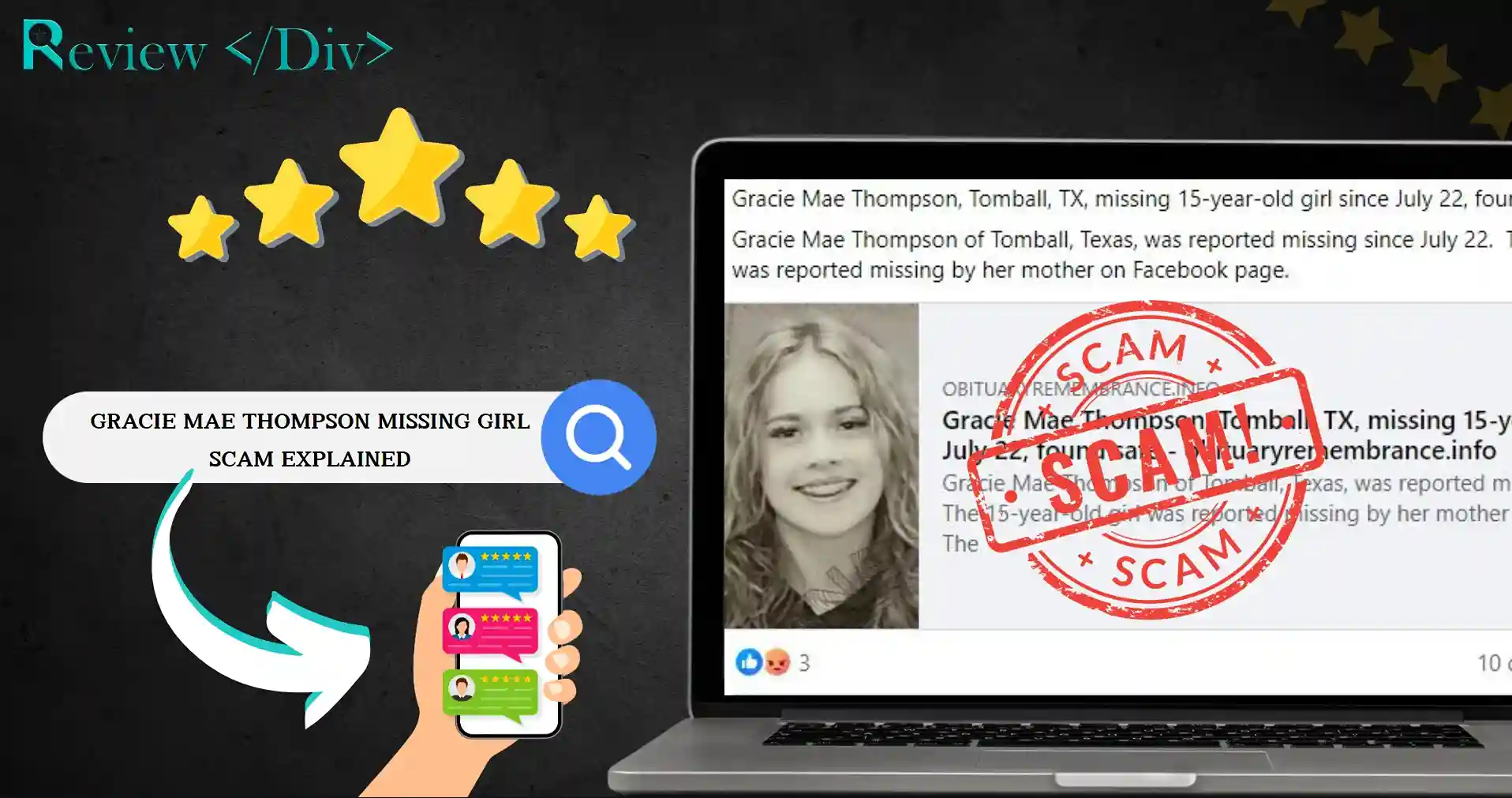Nowadays, scams are becoming more common, particularly those that play on our emotions. The Gracie Mae Thompson Missing Girl Scam is a clear example of this, as it uses a fake story about a missing child to trick people into sharing false information.
In this post, we will review Gracie Mae Thompson Missing Girl Scam, how this scam operates, and what to do if you fall for these scams.
What is Gracie Mae Thompson Missing Girl Scam?
The Gracie Mae Thompson Missing Girl Scam is a deceptive scam circulating on Facebook. It falsely claims that a 15-year-old girl named Gracie Mae Thompson went missing in Texas on July 22, 2024.
This scam uses the emotional response associated with missing person cases to trick people into sharing the post, thereby increasing its visibility and reach. The posts involved in this scam include descriptions of the girl’s appearance, and manufactured details about her.
Gracie Mae Thompson Missing Girl Case Overview
The Gracie Mae Thompson story started to circulate on social media mainly on Facebook, where posts claimed that she had gone missing. These posts included detailed reports of her physical appearance such as her height, weight, and hair color—along with urgent pleas for help finding her.
The posts hit an emotional chord with many people, directing them to share the story widely in hopes of contributing to her safe return.
As the story spread, however, some people began to notice something was off. although the posts had emotional appeal, no official announcements or news reports assuring that Gracie Mae Thompson was missing.
No Amber Alert was issued as a standard procedure in cases of missing children. This absence of official confirmation caused some to question the legitimacy of the claims.
How Does Gracie Mae Thompson Missing Girl Scam Work?
The Gracie Mae Thompson scam follows a familiar pattern seen in many social media frauds. Here’s how it works.
1. Creation of the Initial Post
The scam starts with a post claiming that Gracie Mae Thompson has been missing for a certain period. This post includes emotionally charged language, urging viewers to share the information quickly to help find the missing girl.
2. Viral Spread of the Scam
Once the post is shared, it can rapidly go viral, accumulating hundreds or even thousands of shares in a short time. The emotional appeal of a missing child encourages users to act without verifying the accuracy of the information.

3. Spreading Misinformation
The scam is further complicated by inconsistencies in the story’s details. Different posts claim that Thompson disappeared from various locations, such as Texas, Columbia Gorge, or Stockton.
4. Using Sympathy
Scammers exploit the natural human instinct to assist those in distress. By crafting a report around a missing child, they manipulate users into spreading the post, thereby increasing its reach, all without any factual basis.
5. Financial Exploitation
These scams can lead to financial exploitation. Scammers direct users to phishing sites or solicit donations under the deception of supporting efforts to find the missing girl.
Public Reaction and Implications On Gracie Mae Thompson Missing Case
The public reacted to the Gracie Mae Thompson case with concern and sympathy. Many people shared the posts, genuinely believing they were helping in the search for a missing girl. However, as more information came to light and it became clear that the case was likely a scam those feelings of sympathy turned into anger and a sense of disloyalty.
This incident flashed discussions about the importance of verifying information before sharing it on social media. When false claims about missing persons circulate, they can harm not only by misleading people but also by diverting attention and resources away from genuine cases.
The case has created a psychological effect on those who shared the posts in good faith. Many people felt manipulated, and this experience made them less engage with or support legitimate causes in the future.
Gracie Mae Thompson Missing Girl Reddit
Many users feel upset that scammers would use the emotional response associated with missing children to spread false information.

Some users have shared their experiences of initially believing the scam and later realizing they had been misled.
What to Do If You Fall for This Scam?
If you have interacted with or shared the Gracie Mae Thompson scam, it’s important to take the following steps to minimize the damage.
Stop Sharing the Post: If you realize the information is a scam, stop sharing it immediately. This helps prevent the further spread of misinformation.
Report the Scam: Use the reporting features on the social media platform to flag the post as misleading or fraudulent. This can prompt the platform to take action against the scam.
Verify Before Sharing: Before sharing any missing person posts, always verify the information. Check credible news sources or official channels, such as law enforcement agencies or missing persons organizations, to confirm the legitimacy of the claim.
Educate Your Network: Inform your friends and family about the scam to prevent them from falling victim. Sharing knowledge about common scams helps build a more informed community.
Stay Alert for Similar Scams: Remain alert for other scams that use similar emotional triggers. Scammers often adapt their tactics, so staying informed can help you recognize and avoid potential fraud.
FAQs
No, Gracie Mae Thompson is not missing. The story about her disappearance is part of a scam circulating on social media, designed to mislead and exploit people’s emotions.
Gracie Mae Thompson is a fictional character created as part of a scam that falsely claims she is a missing girl. The story is entirely made up to manipulate and deceive social media users into sharing the fake post.
It’s a fake viral Facebook post claiming that a 15-year-old girl named Gracie Mae Thompson went missing from Texas in July 2024, using a photo and an urgent plea to get attention.
Don’t share it. Report it to Facebook as a scam, delete it if you’ve shared it, and let your friends know it’s fake.
Check if it’s reported by credible news sources or law enforcement and see if there’s a clear call to action, like contacting the police.







